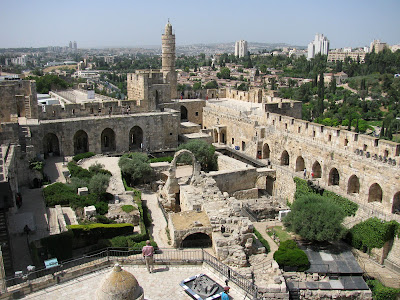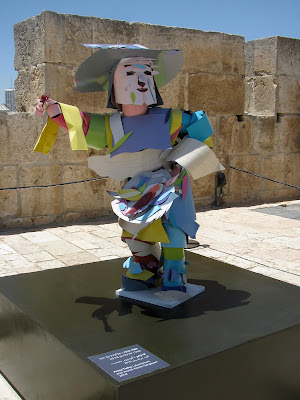We continued through the citadel, examining Hasmonean and Herodian walls along the way, then entered a dry moat surrounding the citadel where we were shown a magnificent stepped pool that was part of King Herod’s Palace. Jewish historian Flavius Josephus tells us that Herod's Palace complex, begun in the last quarter of the first century BCE, comprised a palace with two wings divided by pools and gardens and was protected by three large towers on the northwestern corner of the precinct.
In 1898 the moat in which we had walked was narrowed and blocked up to enable carriages to enter the Old City during the visit of the German Emperor, Wilhelm II. Among the enormous changes carried out by the Turks in the Jaffa Gate plaza prior to the emperor's visit, the most significant was the destruction of part of the wall next to the gate, when the moat was filled in with earth. Later the moat was turned into a shuk (market) for Jerusalem traders.
The prison corridor in the days of the British Mandate.
To see the Kishle itself we climbed a circular metal staircase to a fenced roof, before entering the barracks. A long hall of concrete, stone and dirt greeted us. Work beneath the barracks is still very much in progress.
The Kishle was first built in 1834 by Ibrahim Pasha, the Egyptian ruler of Palestine at the time. The building continued to be used as a military compound when Ottoman rule resumed in the city in 1841, and during the British Mandate it was used as a police station and a prison where some members of the Jewish underground were incarcerated. It stopped being used as a prison after Israel recaptured the Old City during the 1967 Six-Day War, and the nearby headquarters building became an Israeli police station.
Turkish soldiers of the Camel Unit in the Kishle, 1910.
Photo from National Photo Collection of Israel.
Investiture by Prince Arthur, Duke of Connaught, in Barracks Square, 19th March 1918. This image clearly shows the Kishle as a two story building with a tiled roof.
Photo from Israeli Decorations.
Prince Arthur, third son of Queen Victoria, presents medals and honours in Barracks Square. Note the Kishle on the left. 19th March 1918.
Photo from Israeli Decorations.
Our guide showed us photographs from the period of the British Mandate. General Allenby was here and in the stormy years that followed the building was used to hold Irgun fighters struggling to establish a Jewish state. They left their mark on the prison walls, below, with the Irgun emblem - a map which shows both Mandatory Palestine and the Emirate of Transjordan, which the Irgun claimed in its entirety for a future Jewish state - as well as the name of the 'artist', Shmuel Matza, a former Irgun fighter and then a lawyer. Detained in autumn 1947, Matza slipped his breakfast fork in his pocket just before the guards accompanied him back to his quarters and when the lights went out and everyone was sleeping, including the police officers, he quietly carved the emblem of the Irgun and his name deep into the prison walls.
Pulling up the floorboards, archaeologists found layer upon layer of Jerusalem's history. They found an 11th century cloth-dying and leather-tanning factory, demonstrating Jewish life in Jerusalem during the Crusader period, as recorded in the diary of Jewish traveller Benjamin of Tudela, who visited Israel in 1172. Around 200 Jews were believed to be living in the vicinity of the citadel. They discovered the foundations of King Herod's Palace, described as the most magnificent dwelling in the entire Roman Empire, lined in marble and decorated in gold. Many believe the palace may have served as the Praetorium, the site of Jesus' trial by Pontius Pilate, along the original route of the Via Dolorosa that Jesus followed to his crucifixion. Next to the palace foundations they found the walls built by the Hasmonean kings at the end of the second century and early first century BCE, and a wall built by King Hezekiah in the 8th century BCE.
* This post has been shared on All Seasons, The Good. The Random. The Fun., Wordless Wednesday (on Tuesday), Sharon's Souvenir's, Our World Tuesday, Foto Tunes, Travel Tuesday and My Corner of the World.

















































































